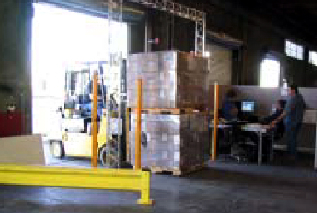Apr 12, 2004Kathy Smith, an executive in the Office of the Secretary of Defense, briefed attendees on several passive RFID implementation projects that the U.S. Department of Defense has undertaken.
The first is at the Norfolk Ocean Terminal, a facility that provides a waterfront logistics support. At a freight consolidation station within the facility, the DOD is consolidating shipments of material bound for various overseas locations. The terminal is implementing RFID to increase inventory accuracy and enhance visibility in the facility and to eliminate the hand scanning that had been required for material as it was being staged to go into shipments.
The second operational implementation is for tracking suits that protect soldiers, sailors and airmen from chemical and biological hazards. The goal of the implementation is to increase the visibility of these critical assets and reduce the amount of handling required to track them. RFID tagging of the suits began in March at the location of a company that supplies the suits. The vendor is sending the tagged suits and an advance shipping notice to one of the DOD's distribution centers.
Smith then provided details on the technology demonstration done in conjunction with the Combat Feeding Program, where meals ready to eat (MREs) were tracked through simulated nodes in the supply chain (see Vendor to Foxhole Tracking).
One of the planned implementations aims to build on the success of the project at the Norfolk Ocean Terminal. Instead of applying the tags at the terminal, the project would push the use of RFID back one node in the supply chain. The DOD would tag goods at one of its major distribution center and then send them on to the terminal. The terminal could then automate the process of receiving the tagged shipments. Smith said that the DOD has done some site surveys and a design for the implementation is underway.
The DOD also wants to test the receiving of goods by "customers"—that is, operational units. So as part of the planned implementation at the DC, the DOD will also tag material being sent to an operational unit at Camp Lejune Marine Corps base in North Carolina.
The military also wants to turn the standard Military Shipping Label, which contains a two-dimensional bar code into an RFID label. The DOD will tag material at three separate airbases in the United States and ship it through the ports of embarkation to the ports of debarkation and read the tags at each one of the in-transit nodes. The tags will be read at a distribution center in Europe and ultimately by a unit in the field.
The goal is to improve efficiencies at nodes along the supply chain and use the DOD's existing in-transit visibility system to collect information about shipments and share it with units in the field. The DOD will be putting RFID readers in the ports to scan the Military Shipping labels. It has conducted site surveys and development of the project is underway.
"We are already seeing benefits from these initial implementations from hands-off data capture to improved processing of material," said Smith. "Most important, we are seeing improved visibility of these critical assets. We are also laying the infrastructure so that we will be ready to received tagged material in January 2005."


